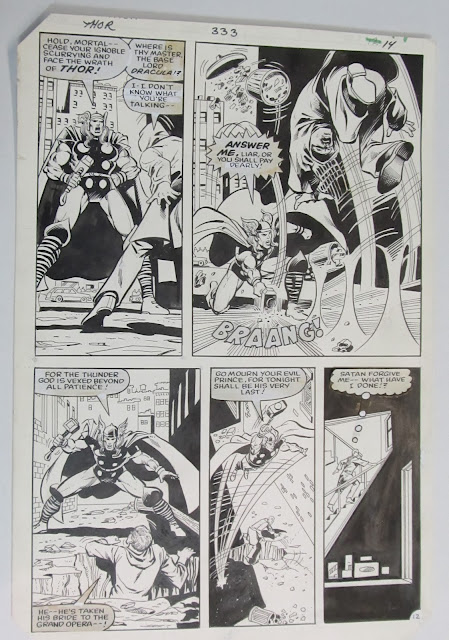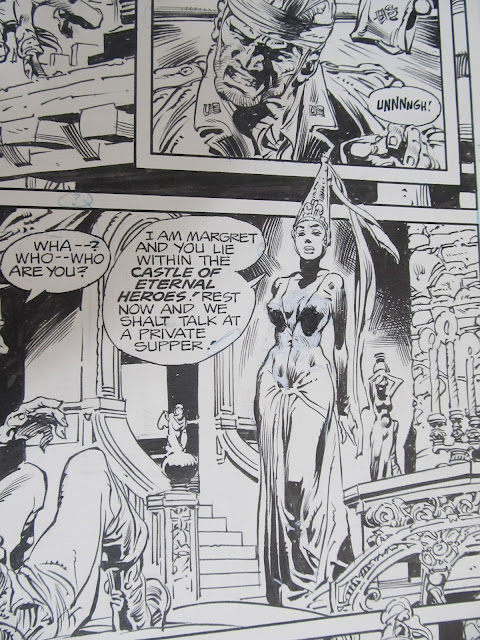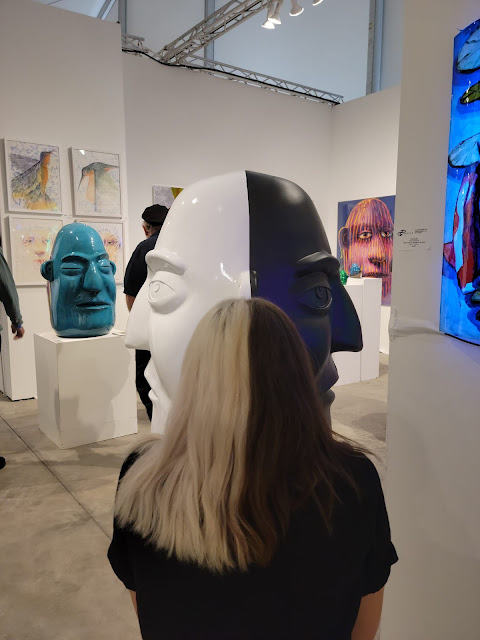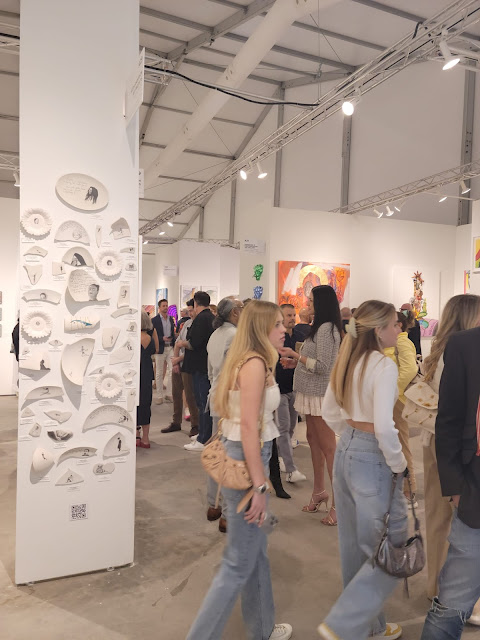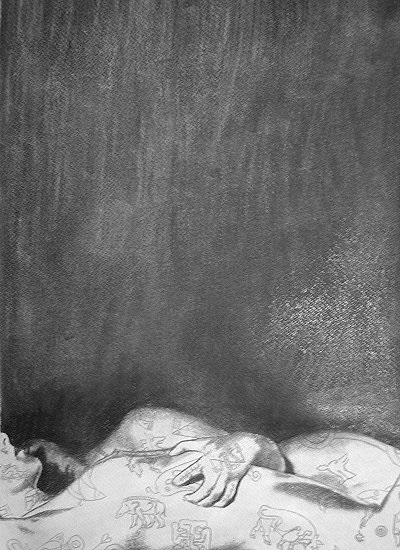The Mighty Thor, issue 333, page 14 published in 1983. Terrific page showing Thor smashing his hammer and then flying away!
Sunday, December 11, 2022
The Mighty Thor - page 14, issue 333
Saturday, December 10, 2022
Have Your Original Essay, Short Story, or Poem Featured and Published
Calling all writers to submit your creative essays, short stories and poems to the Local Writer’s Showcase. Enter to win a chance to win a cash prize, a free membership to The Writer's Center, and first place winners get published in Bethesda Magazine and online on the Bethesda Urban Partnership and The Writer’s Center websites. Adults and high schoolers are encouraged to apply, with winners picked from each group.
The deadline for the Essay and Short Story Contest is January 10, 2023.
The deadline for the Poetry Contest is January 17, 2023.
Partners supporting the contests include Bethesda Magazine, The Writer's Center and The Trawick Foundation.
Thursday, December 08, 2022
Weird War Tales, issue 57, page 5
Weird War Tales, issue 57, page 5 published in 1977. Terrific page showing loads of action and great art! Set in the summer of 1944 in France during World War II, as well as France in 1247.
Wednesday, December 07, 2022
Once upon a time there was a Republic
 |
| Havana street, 1950s |
"Once upon a time there was a Republic. It had its constitution, its laws, its civil rights, its President, a Congress, and law courts. Everyone could assemble, associate, speak and write with complete freedom. Public opinion was respected and heeded and all problems of common interest were freely discussed. There were political parties, radio and television debates and forums and public meetings. The whole nation pulsated with enthusiasm."
- In 1829, Cuba was the first nation of Latin America, and also before several European nations, to use steam ships.
- In 1837, Cuba became the third nation in the world, after England and the US, to build a railroad. It also had the causal effect of creating a significant Chinese immigration to the island.
- The first doctor to use anesthesia in medical operations in Latin America (and also before Spain, Portugal, Italy, France and many other European nations) was a Cuban. It was ether and the year was 1847.
- In 1860, in the city of Cardenas, two clinics started the world’s first health insurance projects. Known then as Mutual Benefit Organizations, these MBO's were the precursors of what are known today in the US as Health Maintenance Organizations or HMO's. Membership in one of Cardenas's MBO's gave its members access to all of the then available medical treatments that the clinics offered. As the medical systems and clinics developed, most Cuban hospitals and clinics provided free healthcare to the poor.
- The first Latin American to play professional baseball in the US (and the “father of Cuban baseball) was the Cuban, Esteban Bellan in 1871.
- The very first demonstration on planet Earth of an industry powered entirely by electricity was in done in Havana in 1877.
- In 1881, a Cuban epidemiologist, Dr. Carlos Finlay, was the first to discover the transmitting agent of yellow fever, the mosquito Aedes Aegypti, which now also happens to carry zika. Dr. Finlay studied medicine at Thomas Jefferson University in the US.
- The first system of electric lighting in all of Latin America, and also before a dozen European countries was installed in Cuba in 1889.
- The first streetcar in Latin America (and before six European nations) began operation in Havana in 1900.
- In 1900, before at any other country of Latin America, the first automobile arrived in Cuba. By 1959, there were more Cadillacs in Havana than in New York City.
- The first Latin American woman to drive a car was the Cuban writer Renee Mendez Cape in 1900.
- The first Latin American Olympic champion was a Cuban. The gold medal was won by the fencer Ramon Fonst Segundo, in 1900 (he also won a silver in that Olympiad). In 1904 Fonts won three gold medals in fencing!
- The first Ibero-American nation to abolish bullfights was Cuba in 1901.
- In 1902, when Cuba finally broke away from Spain, the island had been the source of between 50%-75% of the entire Spanish Gross National Product.
- The first city on the planet to have a direct dialing telephone system was Havana in 1906. The second city in the world to have a direct dial telephone system was Santiago de Cuba, the capital of the Oriente province. All through the first half of the century, Cuba had more telephones per capita than any Latin American country except Argentina and Uruguay.
- In 1907, the first x-ray medical department in Latin America (and before nearly every European nation) was established in Havana.
- On the 17th of May, 1913 the first international aerial flight in Latin America was achieved by the Cuban pilots, Agustin Parla and Domingo Rosillo del Toro. The flight was between Cuba and Bone Key, Florida and lasted 2 hours and 40 minutes.
- Cuba, in 1918, was the first country of Latin America to grant divorces to married couples.
- The first Latin American (and the first person born outside of Europe) to win the world championship of chess was the Cuban master, Jose Raul Capablanca. He’s considered one of the greatest players of all time and was world champion form 1921-1927. He only lost 35 matches in his lifetime.
- In 1922 Cuba was the second nation in the world to have a commercial radio station, and the first nation in the world to broadcast a music concert. By 1928 Cuba had 61 radio transmitters, 43 of them in Havana, giving the nation the fourth place of the world, only surpassed by the US, Canada and the Soviet Union.
- In 1935 the concept of the radio novel and radio series was created by the Cuban Felix B. Caignet. That was the seminal birth of the telenovela as well!
- In 1935, the first black man to play professional baseball in the then segregated Major Leagues (and 12 years before Jackie Robinson) was the Cuban player Roberto Estalella. Cuban professional baseball had never been segregated.
- In 1937 Cuba was the first nation in Latin America (and before most European countries) to establish a legal work day of 8 hours. It also established a minimum wage!
- In 1940 Cuba became the first country of Latin America (and also before many European nations) to elect politicians by universal suffrage and absolute majority.
- Also in 1940, when 70% of the Cuban population was white, Cuban voters elected a black Cuban as President (Fulgencio Batista). Batista was the first (and so far only) black President elected in Latin America.
- In 1940, Cuba was the first nation in Latin America (and before several European nations) to recognize and authorize the right to vote for women, the equality of rights between sexes and races, and the right of women to work.
- In 1942, the Cuban musical director Ernesto Lecuona became the first Latin American musical director to receive a nomination for an Oscar.
- The second country in the world with a commercial television station was Cuba in 1950. Throughout the decade, Cubans had more TV sets per capita than any other Latin American country, and more than Italy, Spain, Ireland, and Portugal.
- Also in 1950, Damaso Perez Prado’s mambo piece Patricia was the number one record for 15 consecutive weeks in the Hit Parade list.
- In 1951, Desi Arnaz became the leading producer in American television. He also pioneered the concept of a third camera in television programming.
- In 1951, the Hotel Riviera became the first hotel in the world with central air conditioning
- A year later, in 1952, the first all-concrete apartment buildings in the world were built in Havana.
- In 1953, about 57% of the Cuban population was urban and more than 50% of the population lived in cities with more than 25,000 inhabitants, 33% lived in four cities with more than 100,000 inhabitants.
- In 1953, one-sixth of the population lived in Havana, making it the third-largest capital in the world in relation to the total number of the nation's inhabitants (after London and Vienna).
- In 1954 Cubans had the third highest meat consumption per capita in Latin America (after Argentina and Uruguay) and higher than most European countries.
- In 1955, Cuba had the second lowest infant mortality rate in Latin America, 33.4 per thousand born and the third lowest in the world. It ranked ahead of France, Belgium, West Germany, Japan, Austria, Italy, and Spain.
- In 1955, life expectancy in the US was 66.7 years. Life expectancy in Cuba was among the highest in the world at 63 years of age; compared to 52 in other Latin American countries, 43 in Asia, and 37 in Africa.
- In 1956, the United Nations literacy report noted Cuba had the second highest level of literacy in Latin America and higher than several countries in Europe.
- In 1956, according to a U.S. Department of Commerce analysis, Cuba was "the most heavily capitalized country in Latin America" and its "network of railways and highways blanket the country."
- In 1957, a United Nations report noted that Cuba had the third largest number of doctors per capita (one for each 957 inhabitants) in Latin America, and more doctors per capita than Britain, Holland and Italy.
- The same UN report also noted that Cuba had the number one percentage of electric access to houses in Latin America (and higher than Portugal, Spain, Greece, Ireland, and all of Eastern Europe and the Soviet Union), and second in Latin America, after Uruguay, in per capita daily caloric consumption (2870 calories per person). This was also higher than all Eastern European nations and three Western European nations.
- In 1957 Havana became the second city on the planet to have a 3D movie theater and a multiscreen theater (the Cinema Radio Center).
- In 1957 Cuba had more television stations (23) than any other country in Latin America, way ahead of much larger countries such as Mexico (12 television stations) and Venezuela (10).
- In 1957 Cuba was first in Latin America, and ranked eighth in the world in number of radio stations (160), ahead of countries such as Austria (83 radio stations), United Kingdom (62), and France (50).
- In 1958 Cuba was the second country in the world to broadcast television in color. The US, of course, was the first.
- In 1958, Cuba was the first country in Latin America, and the third country in the world with the most cars per capita (one for every 38 inhabitants).
- Cuba was also first in Latin America and third in the world with the most electric home appliances per capita.
- In 1958 Cuba was the first country in Latin America and third in the world (after the US and England) with the most kilometers of railway lines per square kilometer and the second in the total number of radio receivers.
- In 1958 Cuba had 58 daily newspapers of all political hues. There were 18 daily newspapers in Havana alone. Bohemia magazine, with a circulation of 250,000, was the largest Spanish language weekly magazine in the world.
- People wanted to immigrate to Cuba – not escape from Cuba! Despite drastic immigration curbs set in place in the 1930s, when European immigrants almost matched the number of natural born Cubans, during the entire decade of the 1950's, Cuba was second in Latin America in the number of immigrants per capita.
- In 1958, and in spite of its small size, and small number of people (6.5 million inhabitants in 1958), Cuba ranked as the 29th largest economy in the world, ahead of several European nations.
- In 1959, Havana ranked as the number one city in the world with movie theatres (358). New York and Paris were second and third, respectively.
- By 1959 Cuba had a large middle class comprising about a third of the population and 23% of the working class was classified as “skilled.”
- In 1959, Cuba's gold reserves were third in Latin America, behind only Venezuela and Brazil.
- Cuba had the third-highest per capita income in Latin America, exceeded only by Argentina and Venezuela (around $550 a year). It was also higher than Italy, Japan, Ireland, Spain, and Portugal and every single Eastern European nation in the Soviet bloc.
"Socialism is a philosophy of failure, the creed of ignorance, and the gospel of envy, its inherent virtue is the equal sharing of misery."
Tuesday, December 06, 2022
"Little White Turd" or the curious case of Professor Susan Eckstein
The famous Cuban poet Reinaldo Arenas, the subject of several movies about his extraordinary life and perhaps the Cuban dictatorship's most notable literary critic, once wrote a devastating poem about American academics who are boot lickers to the Cuban dictatorship while enjoying the benefits of a free nation. He wrote it while in exile in new York City, when (to his horror) he discovered the disturbing number of American academia who supported the Cuban dictatorship.
The poem has recently been re-dedicated by Cuban exiles to Susan Eckstein, a Castro apologist and ardent Cuban dictatorship supporter while demonizing the Cuban Diaspora - she's a Professor in the Pardee School of Global Studies and in the Sociology Department at Boston University and most deserving of the poem.
Professor Eckstein: I join my fellow Cubans in dedicating this poem to you:
Blanco mojoncito,
quisieras ser guerrillero, pero cómo renunciar a
los productos Shaklee, a la loción después del baño,
a la nevera bien surtida ni (oh, de nunguna manera)
a la lectura del New York Times que tan puntualmente
llega a tu puerta.
Blanco mojoncito,
te arroban los desfiles militares y las marchas multitudinarias,
pero tu pie opta por el confortable
Addidas y no por la bota rusa, y tu culo no cambiará
jamás (a pesar de su férrea ideología) el suave
papel sanitario por las cuatro hojas del Granma,
cuya tinta (dicho sea de paso) te dilataría las
hemorroides
Blanco mojoncito,
admiras las vastas plantaciones colectivas (¿koljós
o granjas del pueblo?) donde los jóvenes ya no tienen
que pensar ni soñar, pero permaneces acá en
tu espaciosa habitación refrigerada, armoniosamente
invadida por plantas ornamentales que se
detienen junto a la biblioteca bien surtida donde
un afiche, EL FUTURO PERTENECE AL COMUNISMO,
domina el conjunto.
Blanco mojoncito,
ligeramente bronceado, consistente y pulcro,
comedido y escultórico, residuo casi final de una
dieta rica en proteínas y carreritas en short por
todo el parque, por mucho Baron Dandy o Air
Freshener («shake well before each use») que
esparzas en tu impecable apartamento nada podrá
impedir que tu olor te condene.
Blanco mojoncito,
para ti todo marchará admirablemente mientras
esa teoría que defiendes y tan bien te alimenta
(¡Me dicen que ya tienes hasta el tenore professor!)
no se te aplique en la práctica, matándote de
hambre.
(Reynaldo Arenas, New York, 1984)
Monday, December 05, 2022
Sunday, December 04, 2022
Say it isn't so MSAC!
The Independent Artist Awards (IAA) program will not be offered in the FY2023 fiscal year while MSAC staff work to envision the program for FY2024 and beyond.
From MSAC:
The Independent Artist Awards (IAA) program will not be offered in the FY2023 fiscal year while MSAC staff work to envision the program for FY2024 and beyond. The existing IAA program is structured in a three-year cycle of artistic disciplines (Performing, Visual/Media, Literary). 2022 marked the completion of a full cycle, during which, MSAC received feedback from applicants, awardees, panelists, and staff about how the program could be improved. In FY2022, MSAC completed a yearlong process that resulted in a new program supporting the working and living expenses of Maryland artists, the Grants for Artists program. As the MSAC staff, Council, and public considered the needs and objectives around this new program, questions regarding the IAA program surfaced, underscoring the need for a thorough and thoughtful reconsideration of the intention, structure, and impact of the awards program.
During FY2023, MSAC staff will seek a team of editors from the public to consider how the IAA program looks for the future. The timing of this pause will ensure we can serve all of our constituents to the best of our ability - considering new programs, funding allocations, goals, needs, and MSAC’s staff capacity.
While IAAs will not be awarded in 2023, there are many other MSAC opportunities that support Maryland’s independent artists, including: Creativity Grants; Professional Development; Opportunity Grants; Maryland Performing Artist Touring Roster; Teaching Artist Roster; Public Art Across Maryland; Folklife Apprenticeships; Heritage Awards and; coming in early 2023 - the new Grants for Artists program!
Saturday, December 03, 2022
Art Basel Miami Beach week - The Saturday report
The crowds at Context Art Miami crowds were the largest that I have evr seen in any art fair in 20 years! They just kept coming all through the day.
The only issue was an apparent lack of sales everywhere, which is rather unusual, since art sales at an art fair are in direct proportion to the amount of people attending the fair.
Other than several drawings on Bisque, in our case, we again failed to materialize a significant, larger priced sale.
Sunday remains to "save" the fair.
Tomorrow morning, we'll pre-stage the vans around 6AM on the streets around the fair. We do this in order to save significant time during pack out.
Friday, December 02, 2022
Art Basel Miami Beach week - The Friday report
Friday saw a lot of people strolling through the fairs, heard a few collectors discussing what fair was good and what fair sucked - also that there are about half as many fairs this year as usual, which makes sense as the world recuperates from Covid.
Sold multiple Bisque pieces again and also one of the Cuba series pieces.
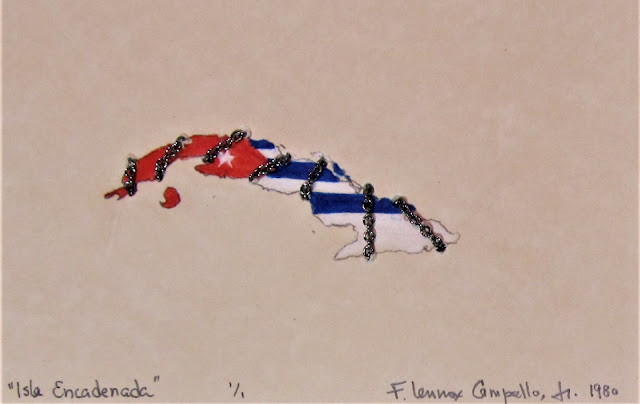 |
| Cuba - Isla Encadenada c. 1980 |
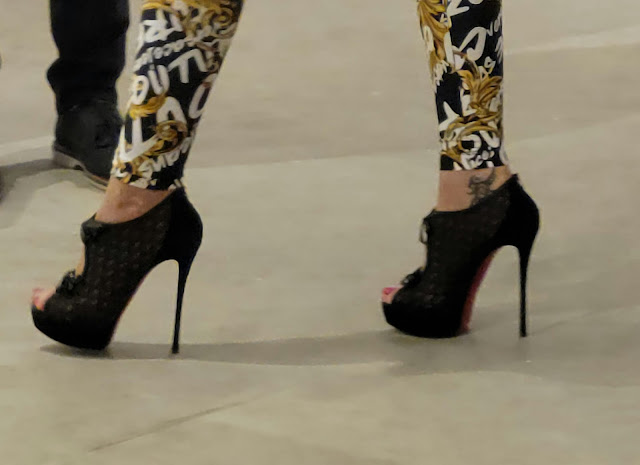 |
| Art fair shoes |
 |
| Art fair shoes |
 |
| Life imitates art |
Thursday, December 01, 2022
Art Basel Miami Beach week - Thursday report
Decent crowds again, although mostly "strolling" through the fair -- not a lot of interested buyers, heavy Florida rains at times, and rather windy by the water.
Press coverage has been good - although rather "recycling" ideas from more than a decade ago, when know-it-alls where predicting the demise of the art fair model. The Art Newspaper calls it "the event that has become most synonymous with art-world excess", which is somewhat true, but showcases the art medias well-known antipathy towards the commodification of art.
Valentina Di Liscia from Hyperallergic title tells you all that you need to know about her outdated angle: Why Is There No Spanish at Art Basel Miami? But she does opine about "art that is mostly drab and uninspiring" and gossips about a rush for "Anna Weyant (who happens to be dating the influential art dealer Larry Gagosian)." She also notes that Latino Miamians are "the most common ethnic group living below the poverty line in the city" in discussing fair ticket prices, but does not tell you that more that half of the wealthiest 1%centers in Miami are also Latinos.
She does nail it with this observation though:
"... an installation by the Brooklyn art collective MSCHF epitomized the worst of art fair gimmick: an ATM retrofitted with a screen that displays users’ account balances when they swipe their debit cards. It was presumably conceived as commentary on wealth disparity, but instead comes off as pretentious and reductive. I’m sorry, but we don’t need an art installation to know that some people have $2M in their checking account and others have $4.50."
I've heard from multiple collectors, including those who bring other collectors from their home states, that the big miss (again) this year is the Untitled art fair, which has been described to me as "too much fiber" and also as "heavy handed curatorial hand."
Artsy's Ayanna Dozier opines on the 10 best booths there... five gets you ten that all of those selections have Artsy accounts. She starts her article like this... cough, cough...
The beachfront setting lent soft, cool lighting to the 11th edition of Untitled Art, Miami Beach, and gave way to an impressive showcase of art. At the VIP preview on November 28th, the breezy atmosphere was matched by a vibrant audience dressed in vivid tones that perfectly complemented the bright white tent and the dazzling works on view. While droves of out-of-towners descended upon the fair, Miami locals were present, too, acquiring works on view while wearing chic beachwear like hot pink shorts and sheer glitter dresses.
Maximilíano Durón from ARTnews has seven different booths as his top choices for the same fair, including a nice look at my good friend Amber Robles-Gordon:
Building on two previous bodies of work, both created since the pandemic, With Every Fibre of My Being (2022) by Amber Robles-Gordon presents a visual summary of the ongoing research that the artist has conducted into her identities as an Afro-Latina of Puerto Rican heritage and as a U.S. citizen living in the District of Columbia. The work, installed in a U shape, is made up of dozens of textiles, many of which are stretched over differently sized hoops used in embroidery and needlepoint. There are prints, florals, sheer fabrics, and fragments of the American flag. In other places are small texts that read “Keep Abortion Legal,” “Make Womanhood Legal,” and “Keep Democracy Legal.”
Five of the seven are Hispanic/Latinos/Latin(x)/Latinas, etc., which tells me something about the Durónmeister's approach... cough, cough...
Finally, Anja Maltav at Miami's iconic Brickell Magazine, and thus the local set of eyes honors me with a selection for their top choices:
Among his most popular productions is his “Cuba Series,” an ongoing collection of art pieces started in the early 1970s. Some were completed before he started formal art training, and the bulk of the work was executed as art school assignments between 1977-81 at the University of Washington School of Art.
Wednesday, November 30, 2022
Art Basel Miami Beach week: Wednesday report
Today Context Art Miami and Art Miami opened to the general public at 11AM, and people dropped by throughout the day, with warnings of heavy showers all day.
Yesterday, at the VIP opening we sold a few of my Bisque pieces and one of Christina Helowicz's unique sculptural works.
 |
| Sculpture by Christina Helowicz |
Tuesday, November 29, 2022
Art Basel Miami Beach week: VIP Preview
Today is the VIP preview for Art Miami and is co-joined sister fair, Context Art Miami. The day starts around 9AM with last minute hanging, re-hanging and labeling... most of the work has been already hung by the crew who arrived here on Sunday, but there's still a lot of work to do.
 |
| The booth before hanging the work |
We're staying on the 22nd floor of the Doubletree skyrise in Wynwood, two blocks from the fair, with an exceptional view of the water and the fair itself.
 |
| J. Jordan Bruns hanging his work at Context Art Miami |
By noon or so the booth is done except for some touch up work and labeling here and there.
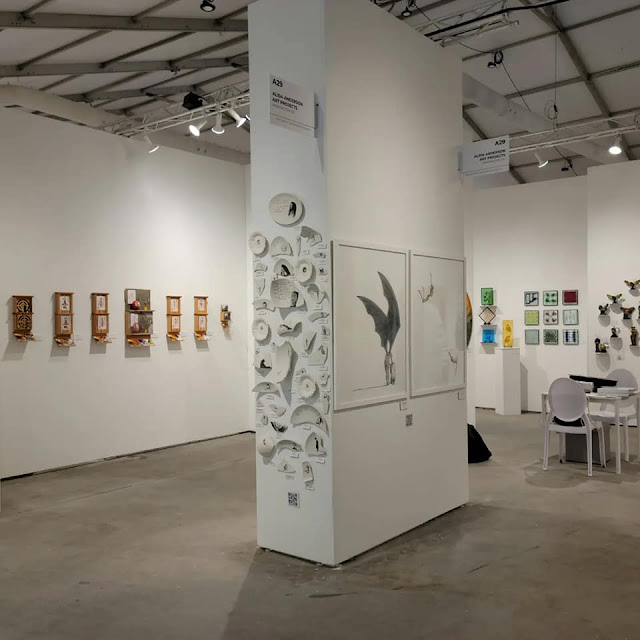 |
| Alida Anderson Art Projects booth at Context Art Miami 2022 |
At 4:30, the VIP Platinum opening starts - by 6:30, when the other VIPs arrive, the crowds really begin to show up - Context Art Miami has started!
Monday, November 28, 2022
Art Basel Miami Beach - VIP Opening minus one
As I write this, it is 3:26PM, EST and I am somewhere flying over the Atlantic coastline heading to Miami for the Art Basel Miami week of art fairs. The airline is Frontier, which is essentially such a no frills airlines, that my roundtrip ticket to Miami was about half the prize of Ubering from my house to BWI and back!
The nonsense of that equation alone is staggering to comprehend in the strange economics of the post Covidian Age.
The fair is Context Art Miami in Wynwood – we’ve done this fair before, in fact we’ve done it many times over the years, including the very first time that the fair made its debut a handful of years ago.
For this iteration, the booth is A29 and will host the work of Tim Tate, Michael Janis, Erwin Timmers, J. Jordan Bruns, Steve Wanna, Marianela de la Hoz, Christina Holowicz and Cory Oberndorfer.
The fair opens tomorrow to the VIPs and Wednesday to the public – in an ideal world, by Friday one hopes to have sold enough work to cover the costs of the booth, thus leaving the last two days to pure capitalistic joy – after all, art is a commodity, isn’t it?
I will, as usual, try to provide my daily report.
By now a lot of work has already happened, vans have been packed and driven (Wanna, Janis, Helowicz and Timmers), unloaded at the fair site in what I have described in the past as the “dance of vans and trucks”, and most of the work hung.
Tomorrow morning the booth is finished hanging by noon (we hope) and labeling affixed, tired bodies are showered and dressed up for the VIP opening, and then the real dance begins.
Sunday, November 27, 2022
Today is Artists Sunday!
Today is Artists Sunday!
Artists Sunday is an annual event that showcases the work of artists and artisans local to you! This year it takes place November 27, 2022.
✓ Artists Sunday is a day to support local artists in your community.
✓ Artists Sunday was created in 2020 to encourage people to shop with artists and buy art as gifts during the holidays.
✓ There’s perhaps nothing more personal than a gift of the arts.
✓ Give something special, unique, and handcrafted this holiday season and support local artists and the local economy.
✓ More than 500 communities across the United States have come together for the second year to champion local artists and promote the giving of the arts this holiday season.
✓ Communities from coast-to-coast, large and small, are celebrating Artists Sunday on Nov 27, 2022 by highlighting local artists, creators and makers and promoting the giving of artistic items and experiences for the holidays.
✓ Positioned during the year’s busiest holiday shopping weekend, Artist Sunday, falls between Black Friday, Small Business Saturday and Cyber Monday.
✓ Artists Sunday unites artists and communities across the country, all promoting shopping with local artists.
✓ Artists Sunday, the Sunday after Thanksgiving (Nov 27 this year), is the world’s largest art event, dedicated to supporting artists and recognizing the impact they have in enriching our lives, communities, and the economy.
By supporting the work of these artists and artisans and creators we not only support and stimulate your local economy, which as most of us know is in dire need of stimulations, but as I’ve discovered over the years, it also offer all of us the opportunity to gift and/or collect one-of-a-kind pieces of art and crafts.
Friday, November 25, 2022
Thursday, November 24, 2022
The Mother of All Rock Fights
Below is a peek from Juicy Fruit Perfume: An American Remembers his Cuban Childhood, my biography, which is currently scheduled to be published in 2024 2026 (should I ever finish it!):
Depending on who you believe, the mother of all rock fights started with either a push, or a slip into the dirty, sewage waters of the Guaso River in Guantanamo, Cuba.
Even now, over fifty years later, it stands out as vividly, as spectacular, as surreal, and as immensely impossible, as on the day that it happened.
Sometimes in the early 1960’s a new baseball stadium was built in the outskirts of Guantanamo, in a neighborhood back then known as San Justo. At the time, to us children it was beautiful new place, a shrine to the love of baseball that all Cubans have. We didn’t notice or care, that all seats were made of cement, and that it was a grim, stark and bare bones space, as if an East German architect had designed it.
But at least to us boys it was a wonderful, beautiful place, where once in a while even the Orientales, the provincial team that represented our honor in the national baseball leagues (and always seemed to lose to the hated Havana teams), played.
My father also loved baseball, and he was the un-official baseball escort for all the boys in the neighborhood, and often he would lead a dozen of us ruffians to a game at the stadium, which was named Van Troi, in honor of a shadowy slain North Vietnamese guerrilla fighter who had been killed in the Viet Nam war.
Why name a baseball stadium after a man who probably never heard of baseball was also a mystery to us, especially since we all knew the names of all the real baseball gods, both Cuban and Americans. But more on baseball later.
As I said, Van Troi Stadium was a few miles outside of the city, and we all usually caught the bus that stopped at the bottom of Second Street, directly across from side of our house that ran downhill through that street. We took that bus to the edge of the city and from there we all walked, usually with hundreds of other people, to the Stadium.
From Guantanamo the trek to the Stadium could be made via two different routes. The longer and safer route was through the metal bridge that spanned the Guaso River. Crossing this bridge was always a thrilling adventure to me. The bridge was a metal arch, and the walkways on either side were made of metal grilles that allowed you to see the river below you as one crossed the bridge.
Because the bridge was – at least in my eyes – just a few feet above the rushing water, there was always a sense of immediacy – and danger – from the fast flowing Guaso River rushing underneath your feet. It was also quite a long crossing, as the Guaso was a rather wide river at that point and often, when augmented by tropical rains (as when the Flora hurricane passed through Oriente province in the early 60’s), would flood the edges of the city. In fact, the metal bridge of my memories may have been a "new" bridge built after Flora, which may have wiped out the older bridge.
Anyway, the bridge crossing was adventurous, and I would always plan it ahead at the beginning of the crossing. I always had a strategy in case I fell off the bridge or in case the bridge collapsed while I was in the middle of it. This always demanded knowing exactly where on the bridge I was, and which direction (backwards or forwards) was the shortest path to land.
Once we crossed the bridge, the road to the Stadium was through a slightly hilly unpaved street, almost a country road, and sometimes we would stop and rest at a house where my father was friends with the family who lived there.
There we would always buy a bottle of pru, which is a homemade Cuban soft drink. We would usually bring the drinks along the rest of the walk to the stadium and sometimes carry extra bottles with us to drink later.
Once, my cousin Cesar had the task of carrying all the extra bottles, and when we arrived at the Stadium, we discovered that he had drunk all of them on the way to the ballpark.
As pru is actually some kind of a fermented non-alcoholic drink, and being homemade, possibly not the purest of drinks, he immediately developed a tremendous case of diarrhea halfway through the game and never made it to the stadium’s bathroom, and managed to shit all over his pants, much to his embarrassment and to our delight.
In any event, this route was the safer, but the longer of the two ways to get to Van Troi Stadium. The second route was a short cut that involved crossing the river though a series of rocks that had been strategically placed at a narrower portion of the river, about half a mile downriver from the bridge.
Now, these weren’t (by any stretch of the imagination), large, flat rocks, but a series of mossy, slippery rocks which sometimes even demanded a slight jump from rock to rock, rather than just steps. In fact sometimes, one could actually step from rock to rock, while other times you needed a synchronized ballet to jump to a small rock, and use it as a spring to the next, larger safer rock, as there was no room in the small rock to actually land and stabilize one’s body. It was a dangerous and almost incredible risk, and yet at the time it seemed as natural as crossing the bridge.
The choice was always based on the availability of the rocks themselves. If the river was too high, then we took the bridge, if the river was low and the rocks exposed, then we’d all cross the river at the rock crossing. Hundreds of people, usually all men and boys, would use this alternate route, all heading to the game through the river shortcut.
To add an ever greater sense of danger to this crossing, was the repugnant fact that the city’s raw sewer lines came out somewhere between the bridge and the rock crossing.
And this was completely untreated, raw sewage at its most luxuriant stage of smell and visibility. The river, which was clean and clear when we looked at it from the bridge, became shit brown and foul by the time it arrived at the rock crossing and turds floated like brown torpedoes all around you as you gingerly made your way across the rocks.
It never occurred to us why the rock crossing had been built after the sewage lines, rather than before it – who knows, perhaps it pre-dated the sewage lines, but the immense danger of crossing the river by skipping across slippery, mossy rocks was multiplied by a million when one considered what would happen if one had the misfortune to slip and fall into the shit water.
And it did happen quite often! Someone would be a little too cavalier in the crossing, or sometimes someone too tipsy from drinking too much beer at the games, lose concentration, slip and fall, to the cheers and laughter and applause of the rest of us. And falling near the riverbed was the worst, as the shit tended to concentrate there, while the river current, although faster and more dangerous in the middle, tended to keep the middle of the river cleaner.
The edges were absolutely gross. A luxuriant, rich, thick mixture of shit and mud demanded strict attention and concentration. In response to this, whoever had originally placed the rocks to build the crossing, had thankfully placed larger rocks at the edges, some of which actually could accommodate several persons at once. This had an indirect cause in the overall accumulations of tiny events that all led to the greatest rock fight in history.
I always recall the crossing of the river at this point as a true adventure.
Sometimes I was a pirate, usually Emilio Salgari's El Corsario Negro, getting away from the Spanish soldiers; at other times I was an astronaut discovering another planet. But I was always in a high state of concentration, always ensuring that I never slipped and always focusing on the next rock, especially when we neared the edges, and the river became a mass of mojones, which is what we called turds, and birds eating all the gross insect life that lived amongst it.
Sometimes a particularly spectacular mojon would float by, or a fleet of mojones, to the delight of us kids crossing the river. We would shout in unison and point to the mojones and exaggerate their sizes and speed. The word mojon is an interesting one, and I’m not sure where it comes from, or if it is a Cuban slang or a true Castilian word. It literally means someone or something that is wet, and has no relation that I can think of to the Spanish word for shit, which is mierda.
Regardless, the river at this point was full of mojones, and stinking of mierda and we would always be alert and I never recall any of our gang falling into the river.
Until the greatest rock fight in history. Truly the mother of all rock fights.
On that particular day, we had all trekked to the stadium not to watch a baseball game, but to watch something different in our perception of sports, at least to Cubans: a soccer match.
While soccer is a big thing in nearly all Latin American countries, in fact nearly a religion in most, it was and probably still is, a curiosity and ignored as a sport by most Cubans.
This arises from the fact that soccer – like bullfights – was a "Spanish sport" enjoyed by Spaniards in Cuba, and thus disliked immediately by Cubans, who wished to remove all things Spanish from the young republic. Spaniards like soccer and bullfights while Cubans preferred baseball and cockfights; Spaniards drank wine, Cubans drank beer and rum, etc.
Anyway, on the day of the greatest rock fight in history, there was a soccer match staged at Van Troi stadium, and as most of us had never seen a soccer match before, a curious crowd of several thousand local men and boys made the trip, either through the bridge or through the rock crossing, and congregated at the ballpark to watch the game.
It was a disaster.
One of the teams had traveled from Havana, and included many Russian players. It was on a nationwide tour to help spread soccer among Cubans. The second team was made up at the last minute from Guantanamo men from the Institute (the local junior college) or local baseball players who had not been selected for any of the national league teams. I bet that for some of the locals, it was the first time that they had ever actually played soccer.
It was the most boring sports spectacle that I recall ever witnessing, played on a baseball field, with the pitching mound still in place, and soccer lines marked at the last minute with white chalk lines.
I recall the entire game consisting of the ball being kicked from one extreme end of the field to the other, with little of the precision and foot skills that only experienced soccer players can display. One just can’t show up one day and decide to dribble with your feet – it just doesn’t happen, and it showed.
And Cubans are just not culturally designed to play soccer, which demands precise teamwork and strategy, as opposed to individualism on the field, which is what the inept soccer players on the soccer pitch, I mean baseball field turned soccer pitch for that day, attempted to do.
The crowd was bored and delighted us by hurling insults at the players, and booing throughout, and only applauding when a fight broke out on the field, which was practically every few minutes, when aggressive, inept Cuban men kicked each other’s shins in futile attempts to get to the ball.
The soccer experiment was a boring disaster, and when the game ended, scoreless as I recall, the crowd was in a dark mood as it left the Stadium and headed back to the city, most of us through the river rock crossing.
And this mood was the second ingredient in the recipe for the chain of events that led to the greatest rock fight in history.
Here is what happened.
I had just crossed the river, and along with my father behind me, begun the slight climb from the river slopes towards the streets above it. At that point, one had a great view of the river and I recall turning around to see the long line of people, like ants, crossing the river, jumping rocks, and making their way back to the city.
And then it happened.
Monguito fell into the shit water; not the middle, cleaner part of the river, with fast moving water and smaller rocks, but near the banks of the river, with turgid, stagnant mud and shit.
Whether he slipped or fell is a matter of debate. As I noted before, these bank rocks were larger and thus "safer" than the smaller, middle-of-the-river rocks, and Monguito claims that as he was standing on one of these rocks, Gustavito, who lived in the house directly below our house on Second Street, and who was a perennial enemy of the Monguito brothers, pushed him from behind.
Gustavito, who was a feisty (and always ready to pick a fight), scruffy, short bulldog of a boy, with a flat top blonde haircut, and he looked like a miniature of his father, who was a professional boxer, has always denied pushing Monguito, claiming that he was nowhere near Monguito when Monguito fell or was pushed in.
Anyway, Monguito emerged from the river completely covered in shit and mud and looking for revenge. The people who were still on the rocks were dying of laughter as he made his way up the banks of the river, and the crossing momentarily stopped as the elder of the two Monguito brothers emerged from the muck. I say "the elder of the two Monguito brothers", as he and his brother Pepin, were always, for some odd reason, referred to as "the Monguito brothers."
Monguito turned to face his laughing tormentors, and he was looking for revenge.
He then spotted Gustavito, still on a rock on the river, also laughing and in fact doubled over with laughter. And in Monguito’s mind, somehow, it became clear that his archenemy had some hand in his fall.
And he picked up a rock, and with the brilliant aim of someone with a thousand previous rock fights of experience, lobbed it in a long arch towards Gustavito, who was too lost in laughter to notice the incoming missile as it hit him and made him fall into the river.
Now the other river crossers really exploded in laughter – this was too much! Two falls in one crossing – this alone was worth the boring experience of the soccer game!
But Gustavito, who had not seen who had thrown the rock, emerged from the river also looking for revenge, and incredibly enough began picking up rocks from the river itself and pelting the crowd with shit covered missiles.
And suddenly pandemonium broke out as people began to fall into the river and more rock throwers were added to the battle. From our safe side on the land, we all joined in to try to nail those still clinging to the relative safety of the rocks.
Some tried to turn back and head to the other side, colliding with crossers coming over and more and more people fell into the water, creating several water battles as men fought each other in the water, on rocks and on the shore.
And the people already on the banks of the rivers were also good targets for us, as we were higher above them on the streets that ran parallel to the river.
And thus, from the relative safety of those streets above the river, we were on a superior position to rain rocks on all of those unfortunate souls below us while being able to dodge all incoming rocks; all except Pepin, who as usual got his head cracked open by a rock, even though he was with us on the streets, desperately, from his superior position, trying to help his brother Monguito below.
And for a glorious ten minutes or so, the greatest rock fight in history went on along the shitty shores of the Guaso River, involving perhaps one hundred men and boys of all ages, with the distinct advantage to those on the shore, many of which were covered in shit, having at one point been on rocks and knocked off either trying to avoid a rock, or being hit by one or pushed by another person attempting to cling to the rock.
If the latter was the case, then it was a matter of honor to get to the shore and attempt to knock off your pusher by nailing him with a rock.
At some point in the battle, even flying turds were being lobbed, to the horror of some of the participants, already covered in shit, who were now being pelted by flying turds and mud.
I cannot remember how and when the greatest rock fight in history ended, perhaps the militia or the cops showed up, but I do recall walking back all the way from the edge of the city to our neighborhood, because there were three in our group completely covered in shit: Monguito, Gustavito and Cesar, who somehow had ended up in the river as well, and Pepin covered in blood from his head wound.
Because of shit and blood, the bus driver would not allow them in, and my father couldn’t leave them to walk alone from that far. It was quite an interesting trek, and we made them walk downwind behind us, only stopping once in a while to break up the occasional fights between Monguito and Gustavito.
When we got home, my grandmother gave my father hell over his supervision of us, and Elba, Pepin’s mother, swore blue murder at my father for not taking Pepin directly to the hospital.
My grandmother then took Cesar to the back garden, where he was hosed down with the garden hose, while the rest of us, less the other two who had fallen in, and Pepin who was on his way to the hospital for his usual visit to stitch up his head, climbed to the roof of the house to watch Cesar being scrubbed clean from head to toe while we drank cold lemonade that my mother had just made.
Thus truly ended the greatest rock fight in history.
